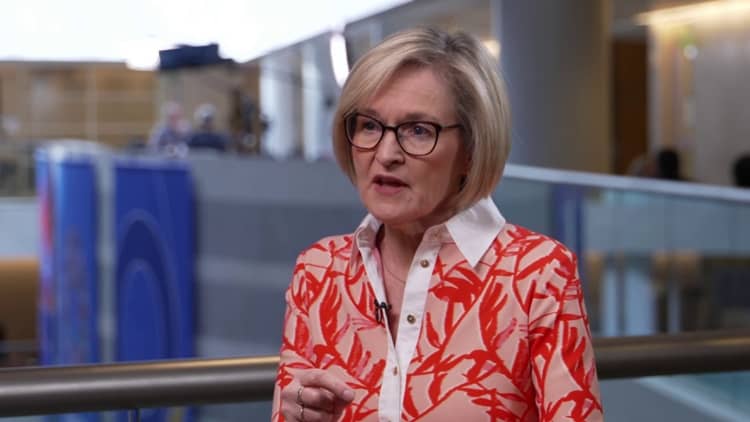
The tide turned against inflation.
Artificial intelligence went mainstream — for good or ill.
Labor unions capitalized on their growing might to win more generous pay and benefits.
Elon Musk renamed and rebranded the social media platform Twitter, removed guardrails against phony or obscene posts and ranted profanely when advertisers fled in droves.
The American housing market, straining under the weight of heavy mortgage rates, took a wallop.
And Taylor Swift’s concert tour scaled such stratospheric heights that she invigorated some regional economies and drew a mention in Federal Reserve proceedings.
A look back at 10 top business stories in 2023:
RAGING AGAINST INFLATION
The Fed and most other major central banks spent most of the year deploying their interest-rate weapons against the worst bout of inflation in four decades. The trouble had erupted in 2021 and 2022 as the global economy roared out of the pandemic recession, triggering supply shortages and igniting prices.
By the end of 2023, though, the Fed, the European Central Bank and the Bank of England had taken a breather. Their aggressive rate hikes had brought inflation way down from the peaks of 2022, when Russia’s invasion of Ukraine sent energy and grain prices rocketing and intensified price spikes.
In the United States, the Fed’s policymakers delighted Wall Street investors by signaling in December that 2024 would likely be a year of rate cuts — three to be exact, in their expectations — and not rate hikes. The Bank of England and ECB sounded a more cautious note, suggesting that inflation, though trending down, remained above their target.
“Should we lower our guard?” Christine Lagarde, the ECB president, told reporters. “We ask ourselves that question. No, we should absolutely not lower our guard.”
The Council on Foreign Relations, which tracks interest rates in 54 countries, found that central banks turned aggressive toward inflation in the spring of 2022. Policies remain tight, the council found, but the overall anti-inflation stance has eased.
AI GOES MAINSTREAM
Artificial intelligence thrust itself into public consciousness this year. But the technology, while dazzling for its ability to retrieve information or produce readable prose, has yet to match people’s science fiction fantasies of human-like machines.
Catalyzing a year of AI fanfare was ChatGPT. The chatbot gave the world a glimpse of advances in computer science, even if not everyone learned quite how it works or how to make the best use of it.
Worries escalated as this new cohort of generative AI tools threatened the livelihoods of people who write, draw, strum or code for a living. AI’s ability to produce original content helped fuel strikes by Hollywood writers and actors and legal challenges from bestselling authors.
By year’s end, the AI crises had shifted to ChatGPT’s own maker, OpenAI, which was nearly destroyed by corporate turmoil over its CEO, and to a meeting room in Belgium, where European Union leaders emerged after days of talks with a deal for the world’s first major AI legal safeguards.
WORKERS SCORE GAINS
The long-battered American labor movement flexed its muscle in 2023, taking advantage of widespread worker shortages to demand — and receive — significantly better pay and benefits. From Hollywood writers and actors to autoworkers to hotel workers, 510,000 laborers staged 393 strikes in the first 11 months of 2023, according to Cornell University’s Labor Action Tracker.
Under its pugnacious new president, Shawn Fain, the United Auto Workers struck the Big Three automakers — Ford, General Motors and Stellantis, the parent of Chrysler, Jeep and Ram — and won pay raises, improved benefits and numerous other concessions.
Hollywood writers and actors, as a result of their walkouts, secured higher pay and protection from the unrestricted use of artificial intelligence, among other concessions.
The unions’ gains marked a resurgence for their workers after years following the Great Recession of 2007-2009 when union power further dwindled, wage gains languished and employers seemed to have their pick of job candidates. An explosive economic rebound from the COVID-19 recession of 2020 and a wave of retirements left companies scrambling to find workers and provided labor unions with renewed leverage
Still, even now, unions remain a shadow of what they once were: As of last year, roughly 10% of U.S. employees belonged to labor unions, way down from 20% in 1983. And back in the 1970s, the United States experienced an average of 500 strikes a year, involving 2 million workers, said Johnnie Kallas, a labor expert at Cornell.
MUSK’S X-RATED TRANSFORMATION
A little more than a year ago, Elon Musk walked into Twitter’s San Francisco headquarters, fired its CEO and other top executives and began transforming the social media platform into what’s now known as X.
Since then, the company has been bombarded by allegations of misinformation, endured significant advertising losses and suffered declines in usage.
Disney, Comcast and other high-profile advertisers stopped spending on X after the liberal advocacy group Media Matters issued a report showing that their ads were appearing alongside material praising Nazis. (X has sued the group, claiming it “manufactured” the report to “drive advertisers from the platform and destroy X Corp.”)
The problems culminated when Musk went on an expletive-ridden rant in an on-stage interview about companies that had halted spending on X. Musk asserted that advertisers that pulled out were engaging in “blackmail” and, using a profanity, essentially told them to get lost.
“Don’t advertise,” X’s billionaire owner said.
HOUSING’S MISERABLE YEAR
Remarkably, the U.S. economy and job market largely avoided pain in 2023 from the Fed’s relentless campaign against inflation — 11 interest-rate hikes since March 2022.
Not so the housing market.
As the Fed jacked up borrowing rates, the average 30-year fixed-rate mortgage rate shot up from 4.16% in March 2022 to 7.79% in October 2023. Home sales crumbled. For the first 10 months of 2023, sales of previously occupied homes sank 20%.
Yet at the same time and despite the sales slump, home prices kept rising. The combination of high mortgage rates and rising prices made homeownership — or the prospect of trading up to another house — unaffordable for many.
Contributing to the squeeze was a severe shortage of homes for sale. That, too, was a consequence of higher rates. Homeowners who were sitting on super-low mortgage rates didn’t want to sell their houses only to have to buy another and take on a new mortgage at a much higher rate. Mortgage giant Freddie Mac says 60% of outstanding mortgages still have rates below 4%; 90% are below 6%.
CRYPTO CHAOS (CONTINUED)
If 2022 was the year that the cryptocurrency industry collapsed, 2023 was the year of the spillover from that fall.
The year’s headlines from crypto were dominated by convictions and legal settlements as Washington regulators adopted a much more aggressive stance toward the industry.
A jury convicted Sam Bankman-Fried, the founder and former CEO of the crypto exchange FTX, of wire fraud and six other charges. Weeks later, the founder of Binance, Chengpeng Zhao, agreed to plead guilty to money laundering charges as part of a settlement between U.S. authorities and the exchange. Among the other crypto heavyweights that met legal trouble were Coinbase, Gemini and Genesis.
Yet speculation that crypto may gain more legitimacy among investors helped more than double the price of bitcoin. After years of delays, regulators are eventually expected to approve a bitcoin exchange-traded fund. Whether that would prove sufficient to sustain bitcoin’s rally over the long run remains to be seen.
BANKING JITTERS
Historically, high interest rates benefit banks; they can charge more for their loans. But in 2023, higher rates ended up poisoning a handful of them.
The industry endured a banking crisis on a scale not seen since 2008. Three midsized banks — Silicon Valley Bank, Signature Bank and First Republic Bank — collapsed.
For years, banks had loaded up their balance sheets with high-quality mortgages and Treasurys. In an era of ultra-low rates, those mortgages and bonds paid out puny interest.
Enter the specter of inflation and the Fed’s aggressive rate hikes. As rates jumped, the banks’ bonds tumbled in value because investors could now buy new bonds with much juicier yields. With pressure on the banks mounting, some anxious depositors withdrew their money. After one such bank run, Silicon Valley collapsed. Days later, Signature Bank failed. First Republic was seized and sold to JPMorgan Chase.
Investors remain concerned about midsized institutions with similar business models. Trillions of dollars in commercial real estate loans that remain on these banks’ books could become problematic in 2024.
GLOBAL MARKETS RALLY
From Austria to New Zealand, stock markets rallied through 2023. As inflation eased, stocks climbed despite sluggish global economic growth.
A tumble in crude oil prices helped slow inflation. A barrel of Brent crude, the international standard, dropped 14% through mid-December on expectations that the world has more than enough oil to meet demand.
An index that spans nearly 3,000 stocks from 47 countries returned 18% in U.S. dollar terms as of Dec. 11. Healthy gains for Apple, Nvidia and other U.S. Big Tech stocks powered much of the gains. So did the 45% return for the Danish pharmaceutical company Novo Nordisk, which sells the Wegovy drug to treat obesity and the 33% return for the Dutch semiconductor company ASML.
The bond market endured more turbulence. Bond prices tumbled for much of the year, and their yields rose, over uncertainty about how far central banks would go in raising rates to curb inflation.
The yield on the 10-year U.S. Treasury briefly topped 5% in October to reach its highest level since 2007. Yields have since eased on the expectation that the Fed is done raising rates.
WORLD ECONOMY’S RESILIENCE
Over the past three years, the global economy has absorbed one hit after another. A devastating pandemic. The disruption of energy and grain markets stemming from Russia’s invasion of Ukraine. A resurgence of inflation. Punishing interest rates.
And yet economic output kept growing in 2023, if only modestly. Optimism grew about a “soft landing” — a scenario in which high rates tame inflation without causing a recession. The head of the International Monetary Fund praised the global economy for its “remarkable resilience.’’
The United States has led the way. Defying predictions that high rates would trigger a U.S. recession, the world’s largest economy has continued to grow. And employers, fueled by solid consumer spending, have kept hiring at healthy rates.
Still, the accumulated shocks are restraining growth. The IMF expects the global economy to expand just 2.9% in 2024 from an expected 3% this year. A major concern is a weakened China, the world’s No. 2 economy. Its growth is hobbled by the collapse of an overbuilt real estate market, sagging consumer confidence and high rates of youth unemployment.
THE U.S. ECONOMY (TAYLOR’S VERSION)
Taylor Swift dominated popular culture, with her record-shattering $1 billion concert tour, her anointment as Time magazine’s Person of the Year and her high-profile romance with Travis Kelce, the Kansas City Chiefs football star.
The Swift phenomenon went further yet. It extended into the realm of the national economy. Her name came up at a July news conference by Fed Chair Jerome Powell, when Powell was asked whether Swift’s blockbuster ticket sales revealed anything about the state of the economy. Though Powell avoided a direct reply, Swift’s name came up that same month in a Fed review of regional economies: Her tour was credited with boosting hotel bookings in Philadelphia.
Economist Sarah Wolfe of Morgan Stanley has calculated that Swifties spent an average of $1,500 on airfares, hotel rooms and concert tickets to her shows (though it’s perhaps worth noting that Beyonce fans spent even more — an average $1,800).
Credit: Source link















